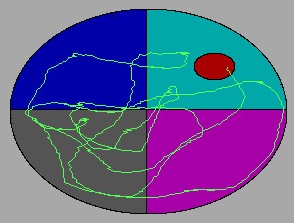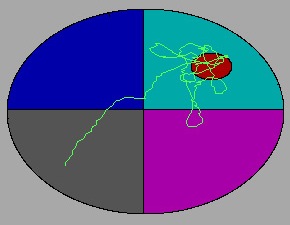Hartman Behavioral Neuroscience Lab:Protocols: Difference between revisions
No edit summary |
No edit summary |
||
| Line 89: | Line 89: | ||
*? | *? | ||
<br> | |||
== Zero maze == | == Zero maze == | ||
See the Cincinatti Children Hospital's zero maze site [http://www.cincinnatichildrens.org/research/cores/abc/elevated.htm here] | See the Cincinatti Children Hospital's zero maze site [http://www.cincinnatichildrens.org/research/cores/abc/elevated.htm here] | ||
| Line 97: | Line 98: | ||
===General methods=== | ===General methods=== | ||
<br> | |||
== Forced swim test of depression == | == Forced swim test of depression == | ||
[http://www.natureprotocols.com/2007/12/13/animal_models_for_depressionli.php protocol] | [http://www.natureprotocols.com/2007/12/13/animal_models_for_depressionli.php protocol] | ||
Revision as of 23:14, 3 November 2008
Water maze









Apparatus
The water maze consists of a metal pool (110 cm diameter) in a well-lit room filled to within 15 cm (???) of the upper edge with water made opaque by the addition of white non-toxic tempera paint. The pool contains a round "escape" platform (11 cm diameter) that the animal can step on to get out of the water. Water temperature is recorded at the beginning of each day of testing and adjusted to within 65-75 degrees F as necessary. After each week of testing, the water maze tank is completely drained and sanitized with Quadracide (2 oz / gal H2O).
General methods
For each trial, an animal is released nose against the wall into the pool at one of four release points and allowed to find the platform. The animals are given 10 trials per day in 5 blocks of 2 consecutive trials with a 10 min inter-block interval. All trials last a maximum of 60 s, at which point the animal is manually guided to the platform. An overhead camera records the animals’ swim paths, allowing for quantification of distance, latency, proximity to target, and swimming speed by a computerized tracking system (Ethovision 3.1). As performance improves, escape latency and swim path length generally decrease.
Cued task
For the cued version of this task, the surface of the escape platform is visible (5 mm above the surface of the water), and a 20 cm tall pole is placed on top of the platform to make its location even more obvious. The location of the platform changes for each block of trials. The animals are released into the pool opposite the location of the platform for that trial, and are allowed to remain on the platform for 5 s. Animals that display behaviors inappropriate for water maze testing (including spinning, thygmotaxic navigation around the perimeter of the pool, and inability to swim) are removed from the water maze study. The maximum amount of time that an animal will swim over the course of one day is 10 min (1 min x 10 trials).
Spatial task
This task is identical to the cued water maze task, except that the surface of the escape platform is submerged 1 cm below the surface of the water and the marker removed, so the animal must find the platform based on its relationship to the spatial cues rather than direct visualization. It will remain in the same location for all 10 trials, and animals are release from all 4 release points at least twice.
Probe trials
After the final spatial trial, the platform is removed and the animal is allowed to swim for 60 s.
Sample counter-balanced design
- 1st 2 SPATIAL trials of each day should be from "far" release points for proper analysis of working memory
- for trials 3-10, counter-balance close and far for each block of 2 trials, with all 4 release points being used for each block of 4 trials
- Day 1 - Cued
- Trials 1a and 1b: platform NE quad, release SW
- Trials 2a and 2b: platform SW quad, release NE
- Trials 3a and 3b: platform NW quad, release SE
- Trials 4a and 4b: platform SE quad, release NW
- Trials 5a and 5b: platform NE quad, release SW
- Day 2 - Spatial location 1 (NE - center of quadrant)
- Trial 1a: S (far)
- Trial 1b: W (far)
- Trial 2a: N (close)
- Trial 2b: S (far)
- Trial 3a: W (far)
- Trial 3b: E (close)
- Trial 4a: N (close)
- Trial 4b: W (far)
- Trial 5a: S (far)
- Trial 5b: E (close)
- Day 3 - Probe 1 and spatial location 2 (W - closer to edge)
- Probe trial: no platform, release SW
- Trial 1a: NE (far)
- Trial 1b: SE (far)
- Trial 2a: NW (close)
- Trial 2b: NE (far)
- Trial 3a: SE (far)
- Trial 3b: SW (close)
- Trial 4a: SW (close)
- Trial 4b: NE (far)
- Trial 5a: SE (far)
- Trial 5b: NW (close)
- Day 4 - Probe 2 and spatial location 3 (E - closer to center)
- Probe trial: no platform, release E
- Trial 1a: NW (far)
- Trial 1b: SW (far)
- Trial 2a: SW (far)
- Trial 2b: NE (close)
- Trial 3a: SE (close)
- Trial 3b: NW (far)
- Trial 4a: SW (far)
- Trial 4b: SE (close)
- Trial 5a: NE (close)
- Trial 5b: NW (far)
- Day 5 - Probe 3: no platform, release E
Notes
- Note that the behavioral tests described do not require the filming or photographing of the animals. The only information that is collected by the camera/computer system is the current X-Y coordinate location of the animal within the visual field. Therefore, no procedures will need to be implemented to secure photographic tapes, films, or files.
Tips, tricks, etc
- having 2 people run the test is preferred
- have lights properly set up before running experiment
Movies
- ?
Time estimates
- ?
Zero maze
See the Cincinatti Children Hospital's zero maze site here
Apparatus
The zero maze consists of a plastic ring, 100 cm outer diameter, 10 cm wide, with 35 cm walls enclosing 2 opposing quadrants.
General methods
